Types of Tomatoes (Best Uses, Flavors, and Plant Sizes)
This post may contain affiliate links. Read my full disclosure here.
What’s the best way to determine the right types of tomatoes for your garden and kitchen? There are thousands of tomato varieties in cultivation, but we can help narrow down your choices.
First, we’ll talk about plant sizes and growth habits. Then, we’ll compare flavors and uses.
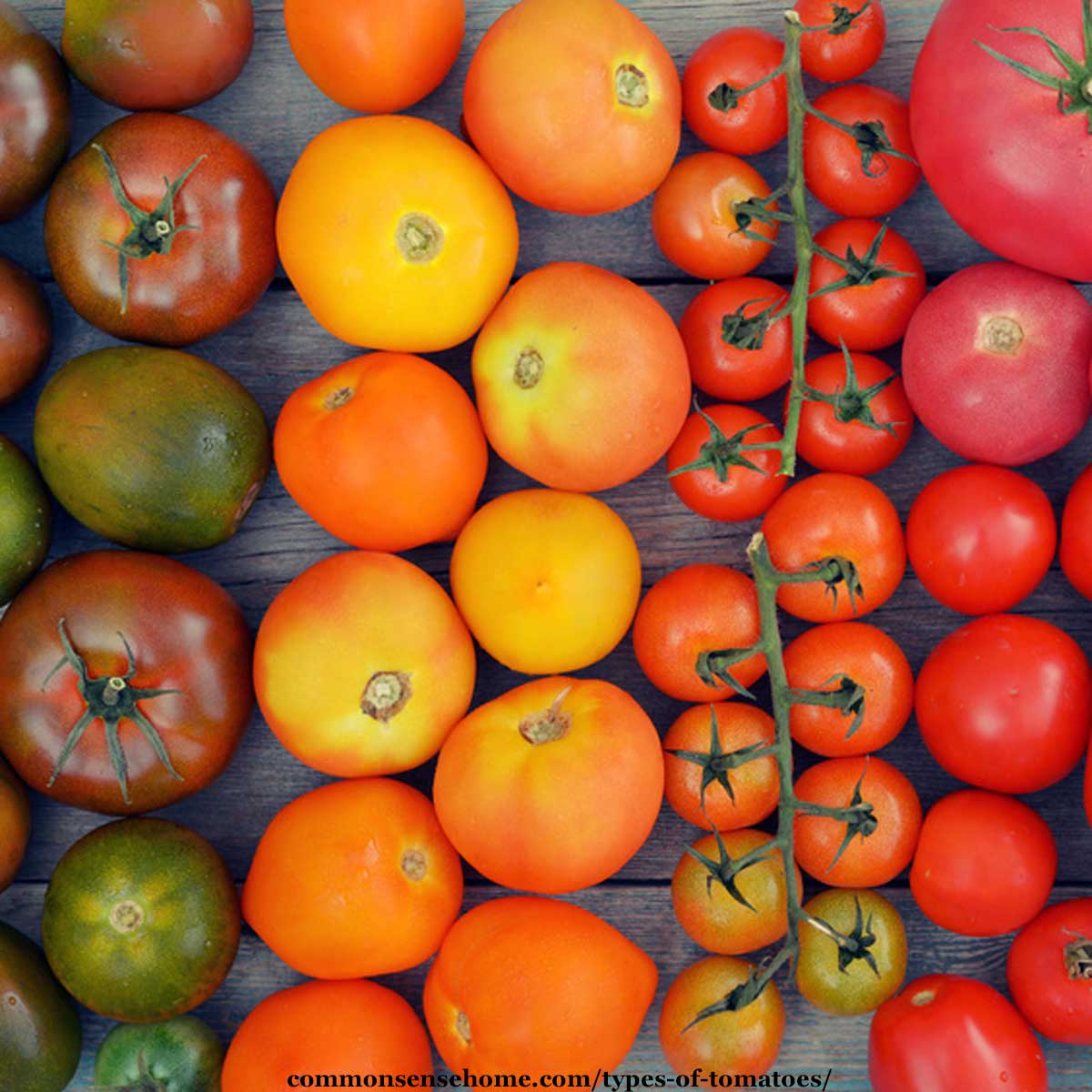
Indeterminate Versus Determinate Tomato Types
Indeterminate tomatoes continue growing and setting fruit until killed by hard frost. Plants can reach 6 feet or more in height, especially in areas with a long growing season.
Plan for a sturdy tomato trellis, and plenty of room for each tomato plant.
Determinate tomatoes are more compact. They reach a certain size and stop growing. Most of the fruit ripens around the same time, making them preferred for commercial processing. Roma tomatoes are common determinate tomatoes.
If you want to grow tomatoes and garden space is limited, determinate varieties are easier to fit into small spaces. Some varieties are even specifically labeled for growing in containers
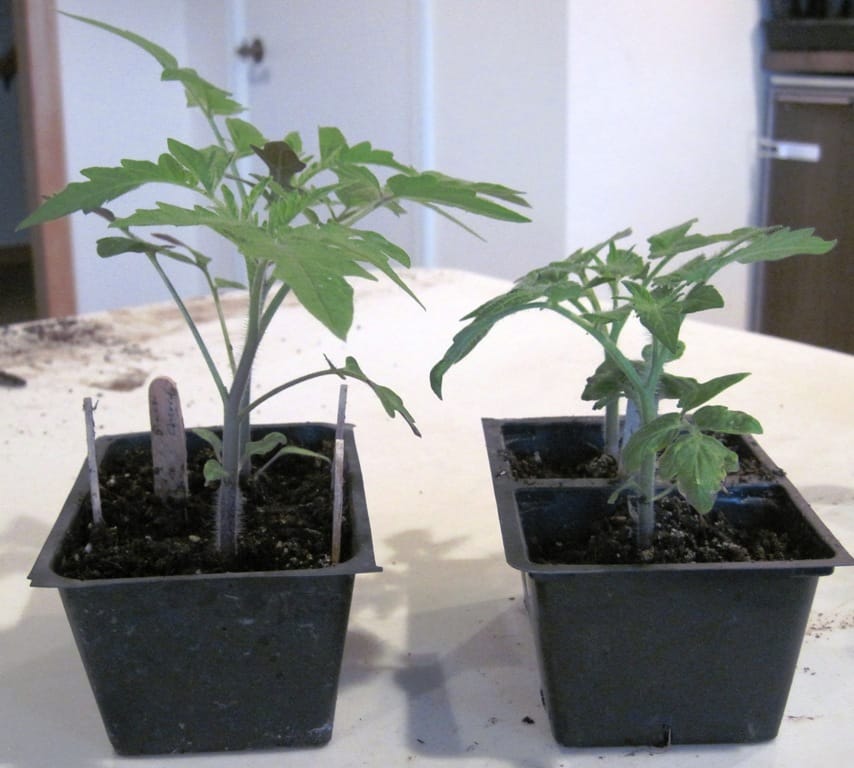
Potato Leaf Tomatoes
Some tomato varieties have larger leaves that look more like potato leaves. These are called “potato leaf” varieties.
The leaf type doesn’t impact the tomato flavor, but it can make it easier to tell your plants apart.
Two of my favorite early tomatoes, Stupice and Glacier, are potato leaf tomatoes.
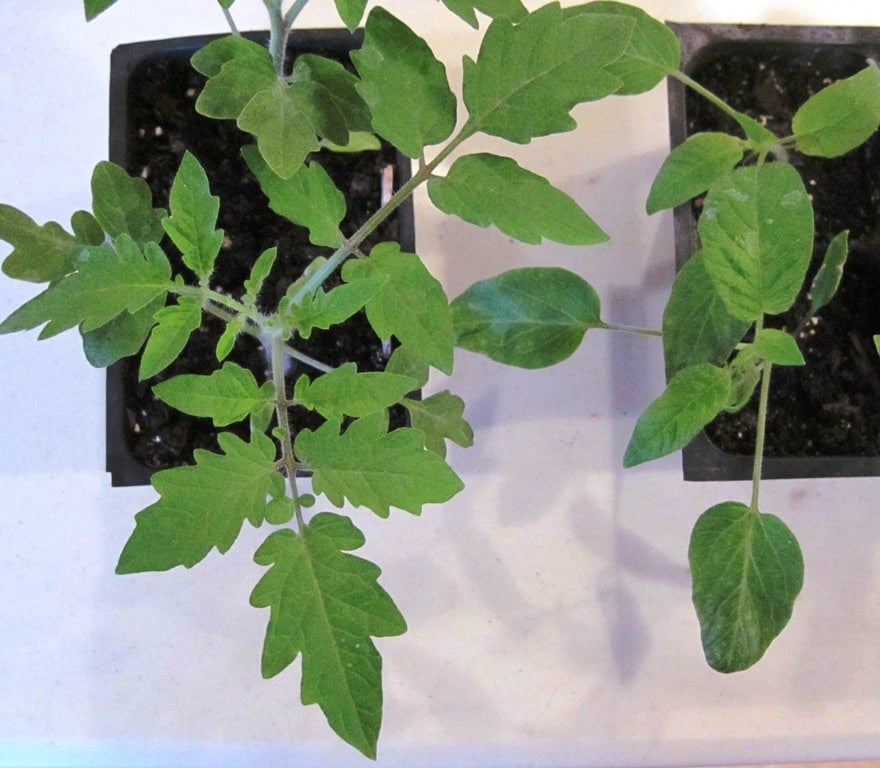
Heirloom Tomatoes versus Hybrid Tomatoes
Hybrid tomatoes are the result of seeds produced by different tomato varieties cross-pollinating. Hybrid varieties often offer disease resistance or other specific traits selected by the breeders.
If you save seed from hybrid varieties, they won’t grow the exact same tomato. Usually, they revert to one of the parent plants, or a new hybrid from cross pollination with other tomatoes.
Hybrid tomatoes are not genetically engineered (GMO). Bees and other insects cross pollinate plants all the time – no lab required.
Heirloom varieties of tomatoes are open pollinated (not people pollinated) and at least 50 years old. They often have great stories about the people who developed them.
One of my favorite heirlooms is Mortgage Lifter, a big, juicy beefsteak tomato. It was developed by M.C. Byles in the 1940s. Mr. Byles sold the plants for $1 each and paid off the mortgage on his house.
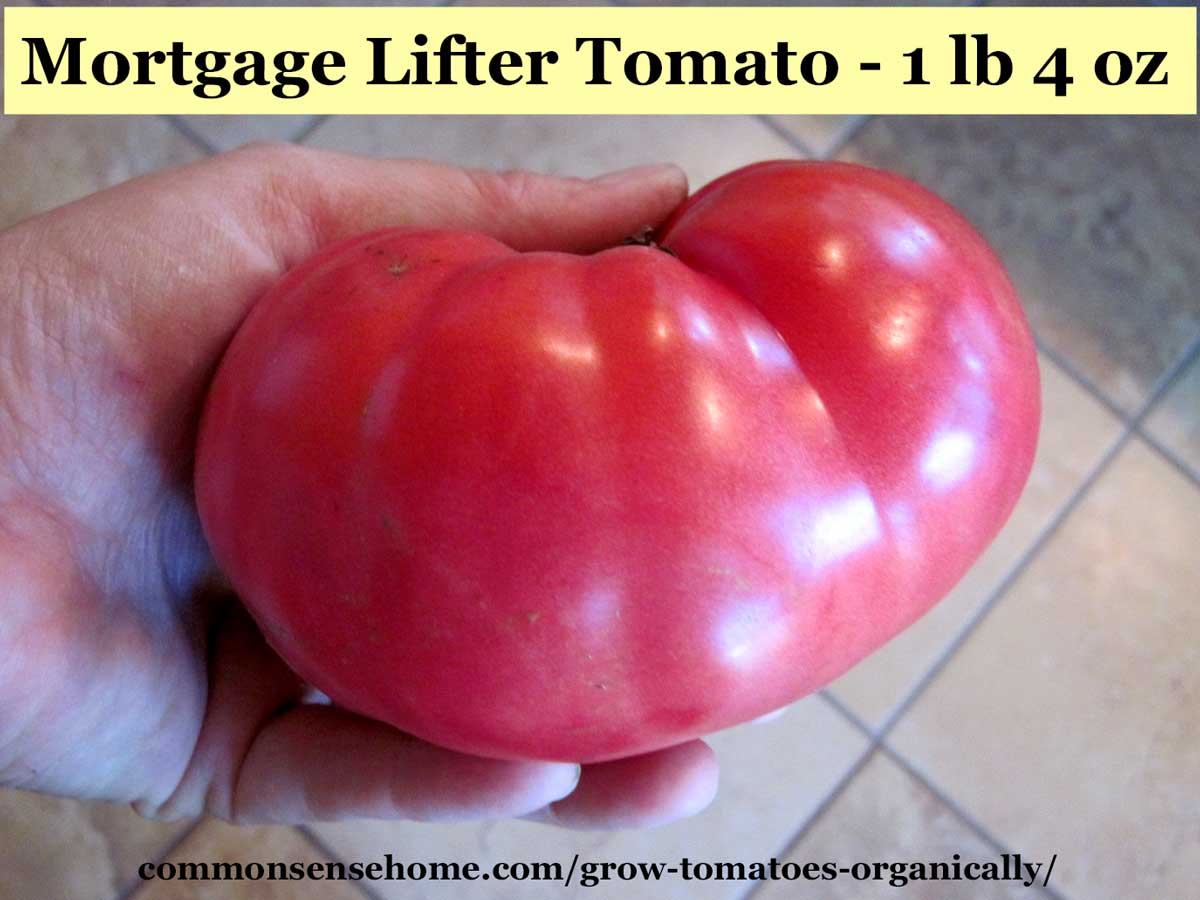
Types of Tomatoes by Use
There’s overlap in tomato uses, but some work better than other for certain recipes.
Paste Tomatoes (Also known as Plum Tomatoes)
Paste tomatoes have thick, meaty walls, and smaller seed cavities. These are great for salsa, tomato sauce and dehydrating.
My personal favorites are:
- Opalka – HUGE, extremely productive, Polish heirloom
- Amish Paste – large tomatoes, good producer
- Cour Di Bue oxheart – good for sauces or slicing
- Orange banana – a heavy produce in my garden
- Purple Russian if we’re expecting an unusually cold season
Roma and San Marzano are other popular paste varieties, but the others work better for me.
Tomato based recipes that work best with paste tomatoes:
- Spaghetti Sauce for Canning (with Fresh or Frozen Tomatoes)
- Home Canned Salsa Recipe – Plus 10 Tips for Safe Salsa Canning
- Tomato Soup – Easy Recipe for Canning or Freezing
- Homemade Ketchup

Slicing Tomatoes
Slicing tomatoes are medium to large fruited tomatoes with plenty of juice. These are most common in grocery stores (along with cherry tomatoes). Think big red beefsteak or medium round red tomato.
Slicing tomatoes are great for fresh eating. They can be used for salsa and sauce, but may require draining or more cooking time compared to paste tomatoes.
Smaller types of tomatoes work well for canning whole. See How to Can Tomatoes in a Canner or Large Pot.
Some of my favorites slicing types of tomatoes are:
- Mortgage Lifter (mid-season, large fruit)
- Garden Peach (long season, medium fruit)
- Stupice (early, medium fruit)
- Glacier (early, medium fruit)
- Defiant hybrid (late blight resistant, medium-large fruit)
Beefsteak Tomatoes
If you want a tomato that can cover a piece of bread with a single slice of tomato, look for beefsteak varieties.
Cherokee purple is an heirloom beefsteak that’s recently regained popularity. Brandywine tomatoes also have many fans, but haven’t flourished in my garden.
Cour de Bue, an oxheart tomato, blurs the line between beefsteak and paste tomatoes. They are the best producer in our greenhouse.
Would you like to save this?
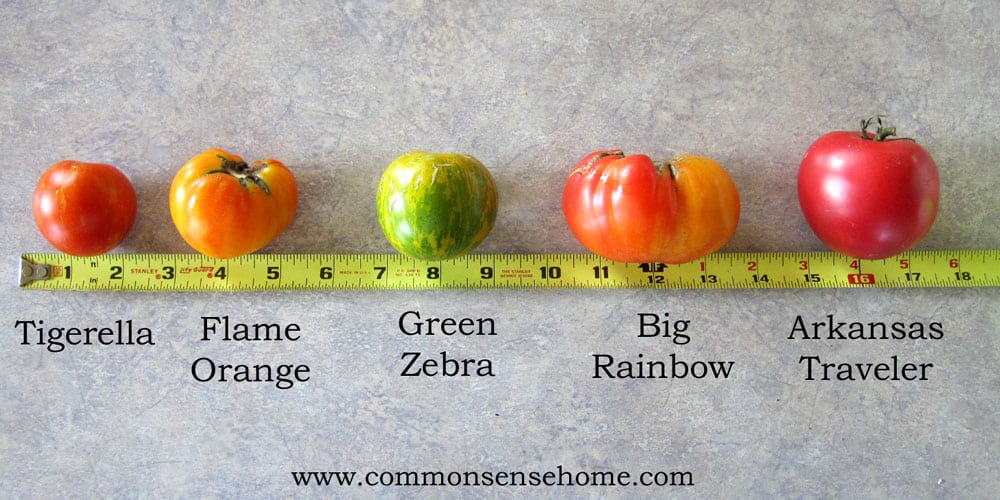
Cherry Tomatoes and Grape Tomatoes
Cherry tomatoes and grape tomatoes are bite sized, generally less than 1 inch in diameter. Small fruited types of tomatoes tend to produce a LOT of fruit.
These are great for snacking right off the vine, in salads, or on the grill.
See Pickled Cherry Tomatoes for Canning, Plus More Cherry Tomato Ideas.
My favorites are:
- Pearly Pink
- Yellow Pear
- Black Cherry
- Sungold
- Peacevine
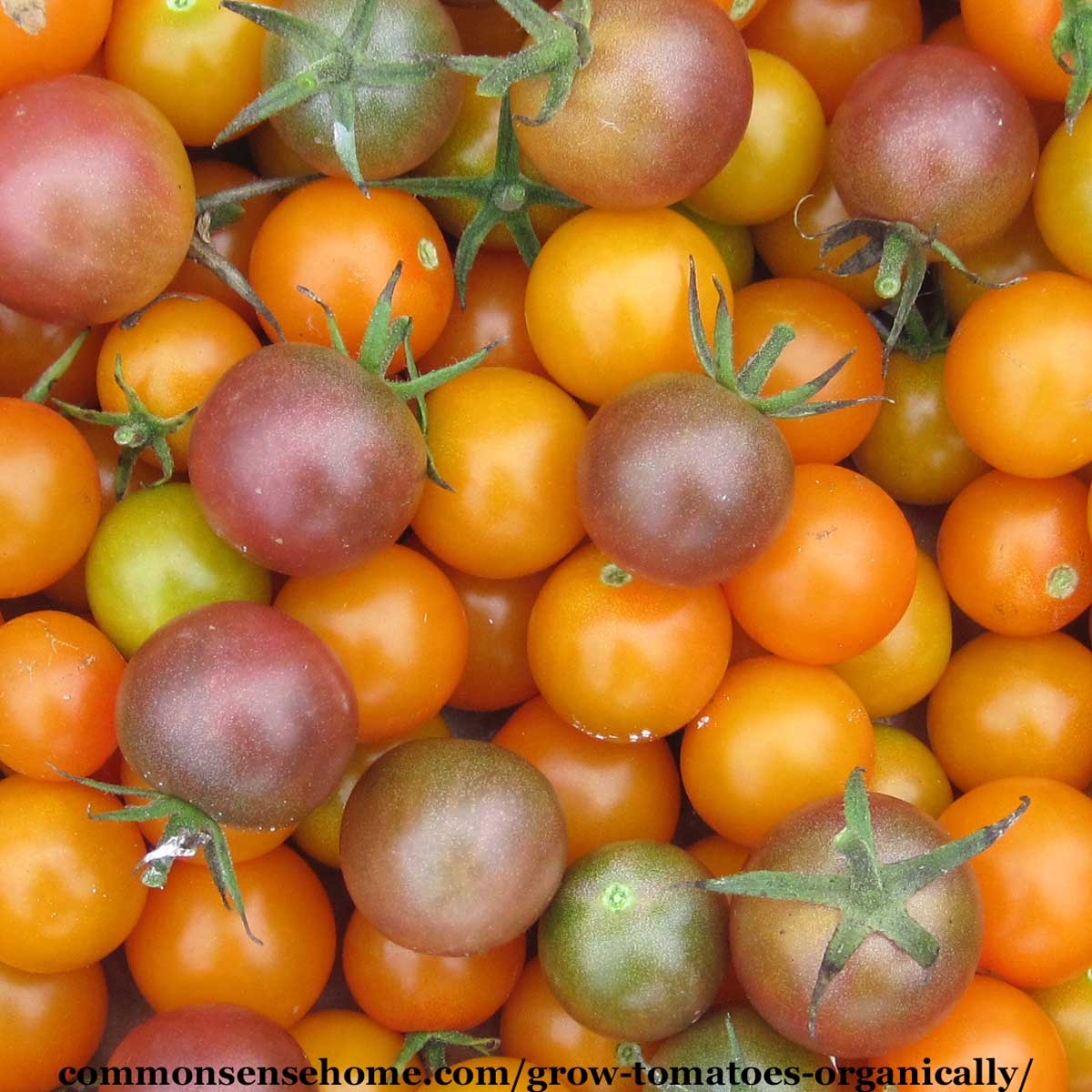
These are so sweet they taste like candy.
Tomatoes on the Vine (Campari Tomatoes)
Many grocery stores now sell tomatoes on the vine, also known as campari tomatoes.
The claim is that they ripen more “on the vine”, but I think it’s mostly marketing. Take a sniff, and you’ll notice that the vine gives off tomato scent before you ever cut into the tomato. All tomatoes, with or without vine, will ripen if picked at full maturity.
See “4 Reasons my Tomatoes Aren’t Ripening” if your garden gems aren’t turning red.
Harvesting the tomato clusters may mean that your tomatoes get a little more care than ping pong ball hard tomatoes bouncing along an assembly line. That said, I’ve still seen some pretty unripe campari tomatoes.
Green Tomatoes
Sometimes green tomatoes are unripe, like those in my pickled green tomatoes recipe. Other times, they’re intentionally green, even when ripe.
Unripe tomatoes need to be cooked or pickled before eating. They have a firm texture and less sweet flavor. This makes them strong enough for frying without getting mushy, and provides a crunchy pickle.
My green zebra tomatoes ripen green with gold stripes. Their sweetness rivals other slicers when fully ripe.
Do Different Colors of Tomatoes Taste Different?
All the different types of tomatoes – slicing, paste, cherry – come in a variety of colors.
From my experience, the variety and growing conditions are more important than the color. Cold, wet growing conditions wash the flavor out of every variety. Warm, dry conditions make tomatoes sweeter.
That said, different colors tend to have different flavors. (With thousands of tomato types, there are exceptions.)
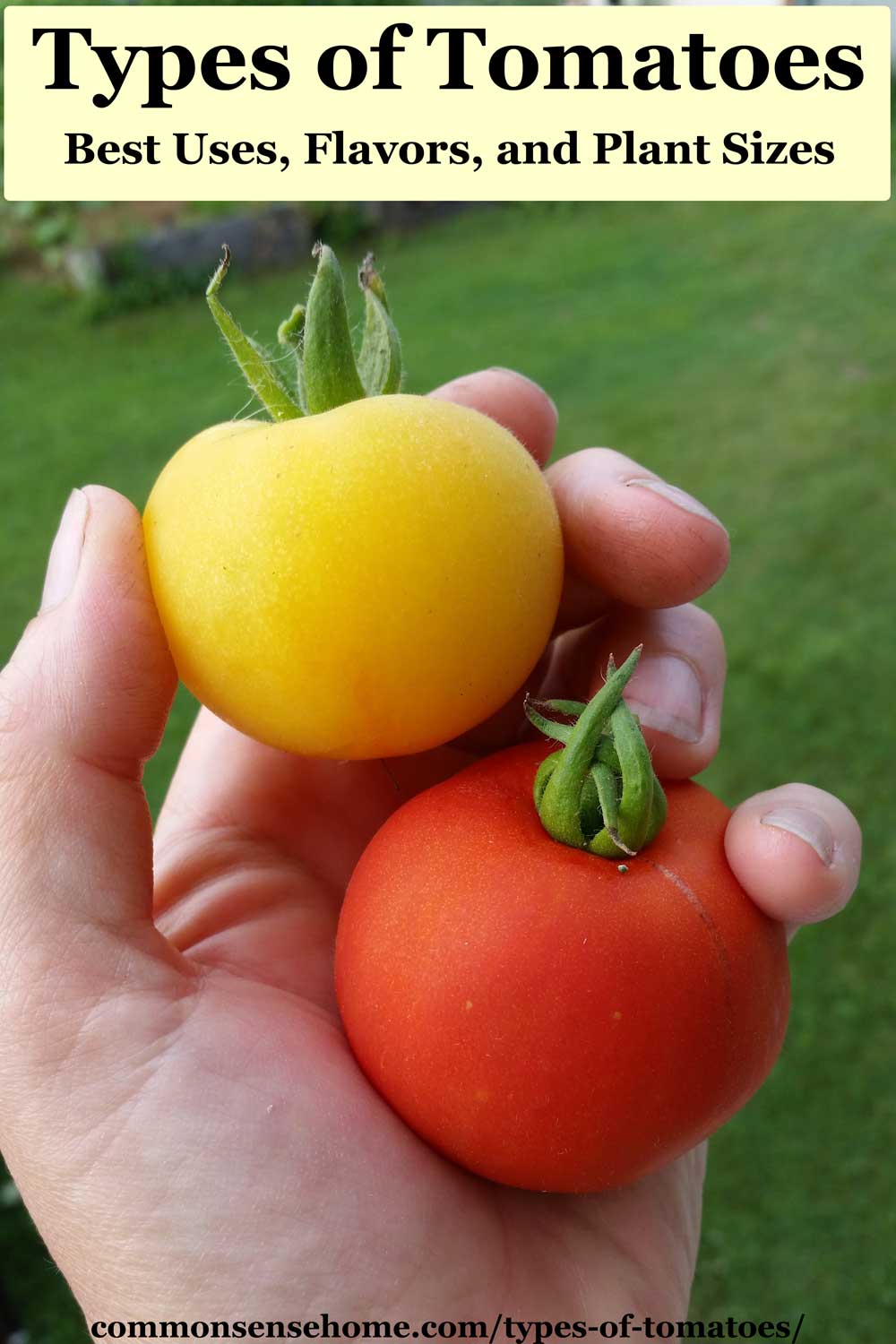
Red tomatoes tend to be more acidic, and the default “tomato” flavor most people know.
Pink tomatoes are generally a little less acidic, and a bit sweeter.
Black and purple tomatoes are some of the sweetest I’ve grown. The big purple tomatoes don’t like my windy garden, but my black cherry tomatoes are wonderful.
Modern blue skinned tomatoes with red or pink flesh taste similar to reds.
Yellow and orange tomatoes tend to be sweet and mild. Small yellow pear tomatoes are particularly mellow.
More Tomato Growing Tips
We have over 100 gardening articles on the site, all sorted by category on the Common Sense Gardening page.
They include:
Grow Tomatoes From Seed – Save Money, Get More Varieties
Growing Tomatoes (Organically) – 11 Tips for Success
Tomato Flowers But No Fruit – Troubleshooting Tips
7 Tips to Stop Blossom End Rot
How to Save Tomato Seeds for Planting
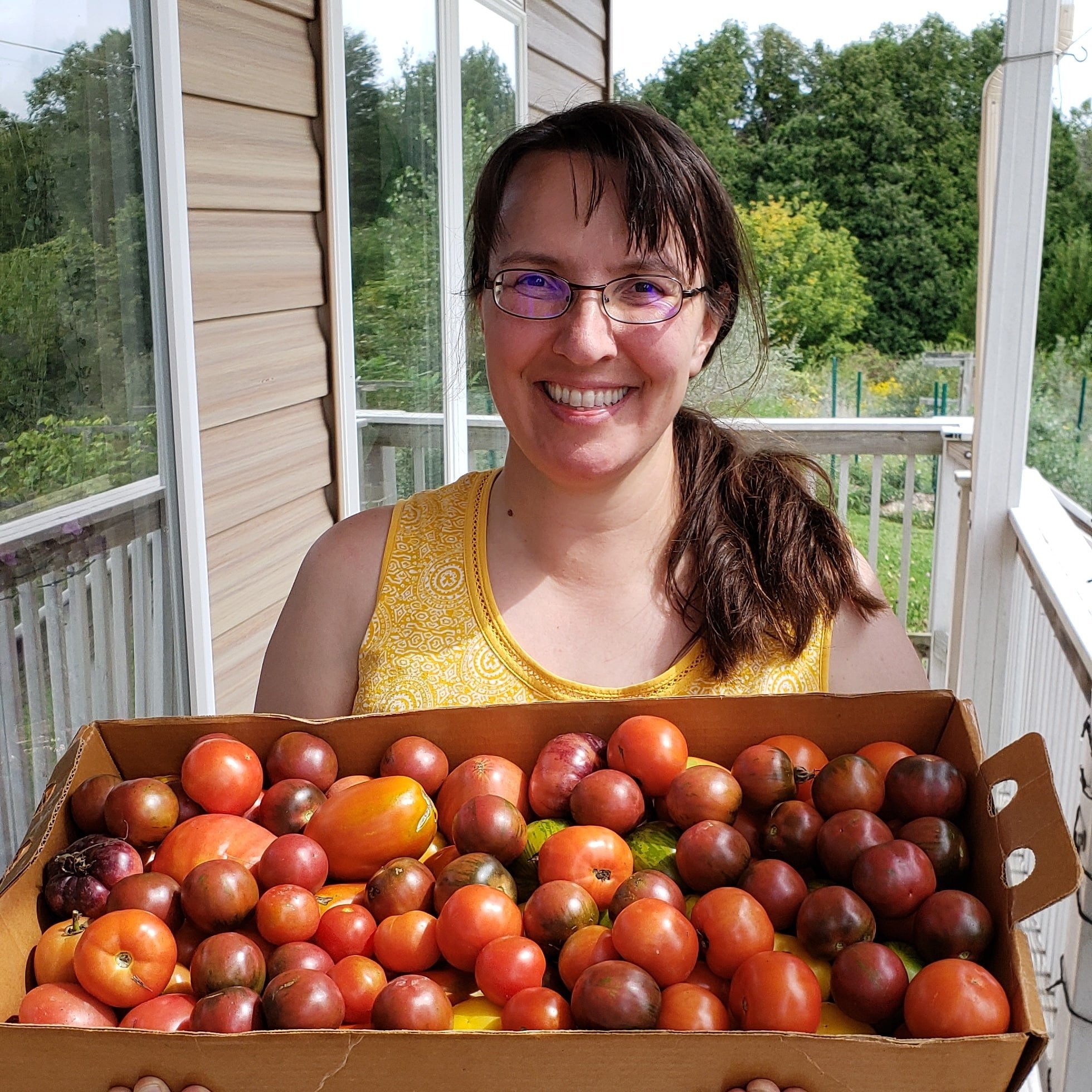
What’s your favorite type of tomato? How do you like to enjoy them?
Share your favorites to help inspire other gardeners (including me).

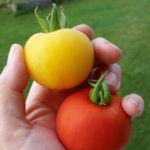
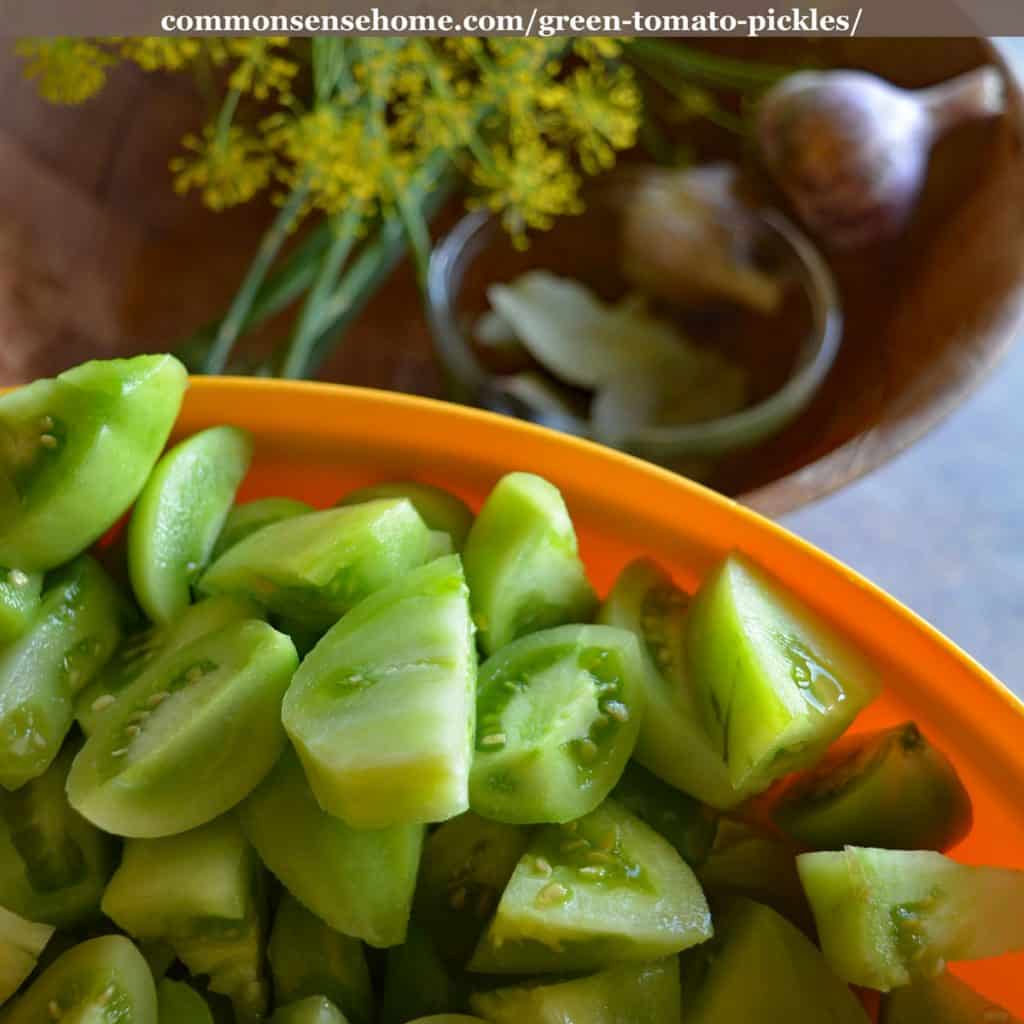
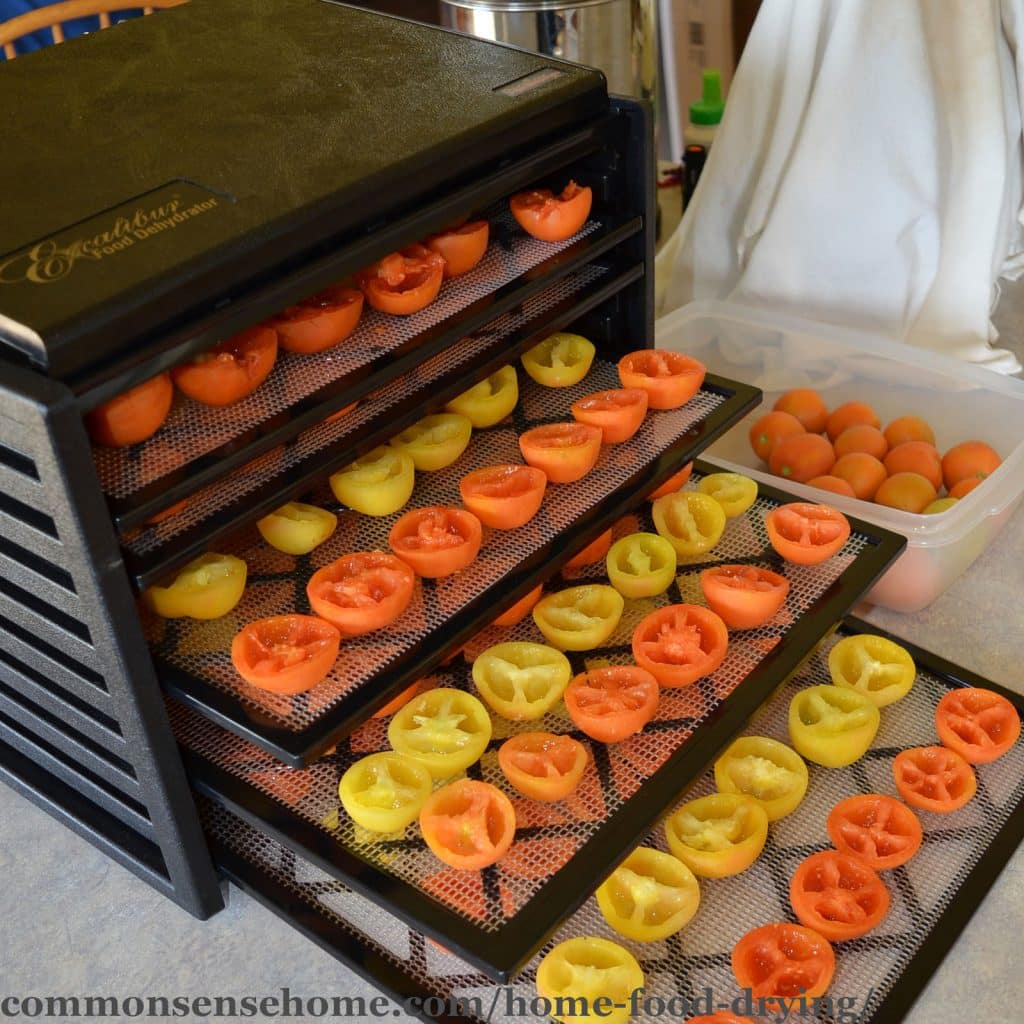
Great article! I tend to default to the same varieties although i am always up to try something new!! But i like to can a lot so plant a lot of beefsteaks! Particularily Brandywine, Rutgers, and a sweet cherry
And I loved the article! I’ll try something different next year!
I always grow Early Girl and various other varieties—Big Beef, have tried many others but haven’t settled on any . I’m in southern Idaho and the plants get to be about 8 feet tall. We are using an arched trellis this year and I’m excited to see how this goes. I always keep extra foliage pruned out anyway .
I don’t have good luck with Romas and as for canning, I slice the tomato horizontally and squeeze out a lot of the seeds and juice and have made lots of salsa and tomato soup that way.
Hi,
I w0uld like t0 ask as t0 h0w many t0mat0es you will plants in y0ur garden etc.
Thanks
Almas Nath00
I usually have 30-40 plants.
The best grape tomato I grow is Brad’s Atomic Grape (Baker Creek seed). My neighbor asked me for a plant for his garden this year after tasting them the last couple years! Yellow Pear are extremely prolific, we only need one plant to get us thru the season!
I am trying two new to me dwarf varietiesm MicroTom and OrangeHat, as I was expecting to only do container gardening this year. As crazy as things have been, I decided to also do an in ground garden this year. That is where I will be putting my Atomic grapes, Dad’s Orange Sunset, a beefsteak variety–don’t recall the name at the moment–and another new to me, Russian Purple. Can you tell I love tomatoes LOL?
I have not had much success with paste varieties, even with recommendations from local gardeners. Not sure why that is. My intention is to can tomatoes for the first time this year. If it means I have to get them from the local markets, so be it. I have frozen tomatoes successfully, and they make a great ‘fresh’ pasta sauce in the middle of the winter!
The atomic grape tomatoes look very like a seed sample we got from Baker Creek several years ago that they called Versiage. (Can’t remember exact spelling ) They were prolific, but didn’t develop great flavor in our garden.
I wonder if your MicroTom is the same as the microtom I tried years ago. The plants were amazingly tiny – less than a foot across – with marble sized fruits.
Same question on the Russian Purple – is that the same as Purple Russian? Those were great for cold weather, but I didn’t grow them this year and last because they are prone to splitting in heavy rains.
I’ve tried about a dozen different paste varieties to get to my favorites. So many people love Roma and San Marzano, but they were some of my worst performers.
You might want to check local growers and see if any offer seconds for canning at a reduced rate.
Over the years I have grown many different varieties of tomatoes. I have finally settled on my 2 favorites: Early Girl and Jet Star. Both varieties produce medium sized tomatoes which are meaty and flavorful. I have an 8 foot trellis which they routinely outgrow with plants reaching 10-12 feet in length.
I grew early girl for years, but haven’t tried Jet Star. You must have a longer growing season, as my plants never get quite that large.